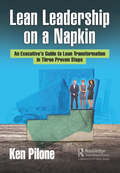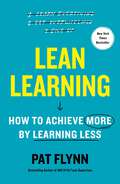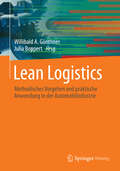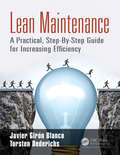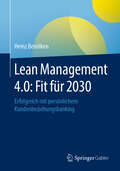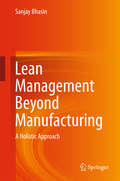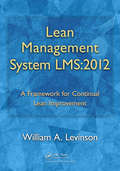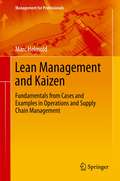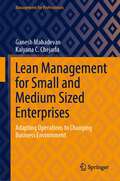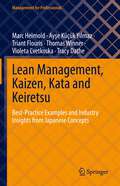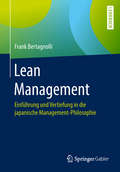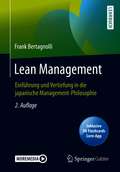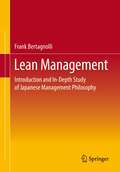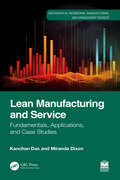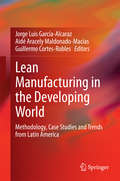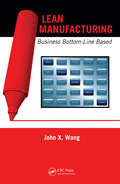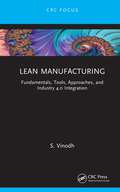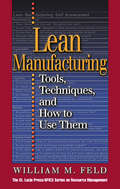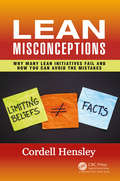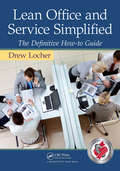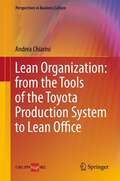- Table View
- List View
Lean Leadership BASICS: Develop and Empower Lean Leaders to Sustain Continuous Improvement
by Michael Meyers Charles W. Protzman III Daniel Protzman William Keen Davide Barbon Cliff OwensThis book explains how to sustain lean, or, continuous improvement practices. It introduces the BASICS® lean leadership development path, combining the "human aspect" with published BASICS® lean tools. It lays out the methodology to empower, lead, and drive ongoing improvements in your business. The book includes engaging stories and case studies to demonstrate the effectiveness of shop floor management tactics, including visual management tools, gemba walks, standard work, time analysis, kanban, 5S, and more.
Lean Leadership for Healthcare: Approaches to Lean Transformation
by Ronald BercawHealthcare organizations that have already applied Lean thinking to their processes, with the diligence of effective management and strong leadership support, are now realizing the benefits of their efforts. And, many of those benefits surpass what was thought possible just a few years ago. To be successful, these organizations had to provide the l
Lean Leadership for Healthcare: Approaches to Lean Transformation
by Ronald G. BercawThe second edition of this Shingo Prize-winning book builds and expands on the first edition. When originally published over ten years ago, there was a need to understand how to lead process and cultural transformation within the healthcare industry. The perfect storm of rising costs, decreasing reimbursements, substandard quality, a shortage of resources, and a new run of better technology and electronic health systems requires leadership to navigate in a different environment.Since the original book, lean improvements have been made to the governance of process and quality improvement programs, and to the management of operations using the daily management system. The core of the book remains the same; however, the results have been updated and made more current, given access to better data and enhanced use of the electronic health record. Extraordinarily good advice is given throughout this book on best practices of what to do and what not to do in leading large-scale change based on another ten years of hands-on experience of the author working in large and small healthcare systems across the country, including case studies that share the time-tested insights of healthcare team members and leaders. The book outlines a management system for sustaining lean improvements and provides the lean leadership approaches, thoughts, and visual tools needed to guide organizations along the path toward world-class healthcare performance. It walks the reader through developing an improvement strategy, laying out a detailed transformation roadmap for initiating, accelerating, and sustaining lean improvements and delivering world-class improvement of outcomes and culture, discussing leadership behaviors necessary for success, and closes with actions that can be used to mitigate risk. It reviews the fundamentals of lean and explains how to link a strategy of continuous improvement to corporate strategy to achieve operational excellence. The book also describes how to mitigate the risk of failure when undergoing large-scale corporate change, including what can go wrong and how to prevent these failures.Updated and refreshed, Lean Leadership for Healthcare remains the gold standard for end-to-end delivery of lean transformation in healthcare. This book is ideal for leaders in the healthcare industry looking to initiate or accelerate lean improvements to clinical and non-clinical processes.Ronald G. Bercaw is the President of Breakthrough Horizons, LTD, a management consulting company specializing in World-Class Improvement through the application of the Toyota Business System, or “lean.” With over 38 years of experience in operations, his hands-on, lean management experience was gained through multiple enterprise transformations in different industries including custom packaging, power reliability electronics assembly, and test and measurement products. Educated at Purdue University, he learned the details and disciplined applications of lean principles, habits, and tools from both the Shingijutsu Sensei and their first-generation disciples. Since leaving industry, Ron has consulting experience in the healthcare sector (U.S. and Canada health systems including primary care, acute care, and community applications of both clinical and back shop operations), the commercial sector (administration, manufacturing, distribution, supply chain, and engineering), and the public sector (U.S. Army, U.S. Navy, U.S. Air Force including Depot Repair Operations, the Pentagon, and Surgeon General Assignments). Ron is also a recognized author with the release of four books, including Shingo award-winners entitled Taking Improvement from the Assembly Line to Healthcare, and Lean Leadership for Healthcare. He is a co-author of The Lean Electronic Health Record, along with Susan Snedaker and Kurt Knoth, as part of the HIMSS book series.
Lean Leadership on a Napkin: An Executive's Guide to Lean Transformation in Three Proven Steps
by Ken PiloneThis very concise and straightforward book is aimed at top executives in virtually any industry who are either new to the concept of Lean and its benefits to them or who have stalled in their transformations and are trying to resurrect their momentum. The book is written in a style that mirrors a typical interaction with an executive across a table with a knowledgeable, experienced Lean coach/consultant. Its style and substance reflect what a candid and casual conversation would sound and feel like. The book includes simple hand-drawn images (thus the title Lean Leadership on a Napkin) to facilitate and simplify basic concepts as if a real dialogue was occurring in an informal setting. It assumes that the executives have a little or no previous knowledge of Lean methodologies or Lean Leadership but have awakened to the possibility of their promise to grow themselves and their enterprises dramatically. Most executives have little time for extensive reading or patience with "sales" presentations. Those same leaders will therefore appreciate the simple, uncluttered, and, above all, objective summary this book provides. The book breaks down the process of transforming the organization around Lean principles into three component transformational phases or steps, namely, Introduction, Integration, and Internalization (i.e., the I-3 strategy). Each phase includes critical factors to understand, do, and share as well as deep reflection questions to help leaders decide on an appropriate path forward for themselves as leaders and for their organizations. While the Integration and Internalization steps are introduced here, the primary focus of this work is on those critical issues arising in the early, Introduction, step. A unique advantage of this book is that it braids together four critical elements of success—Lean concepts/methodology, culture change, leadership, and business performance. Essentially, the reader will obtain a broad, basic, and solid understanding and leadership foundation about Lean, the leader’s unique role in transformation, and confidence to make appropriate decisions about the how and if to proceed. In addition, it will offer a path forward by providing the reader with abundant resources and consulting support for those seeking to launch a Lean transformation.
Lean Learning: How to Achieve More by Learning Less
by Pat FlynnNavigate the chaos of information overload and supercharge your efficiency with Lean Learning, a groundbreaking guide that reveals a counterintuitive approach to success: winning by learning less.From an early age, we&’re taught that more is better. More money, more information, more skills. But times have changed. What was once valuable has now become a burden, and if information alone were the answer, we&’d all be exactly where we want. In today&’s fast-moving world, the difference between success and failure is not in what you know but in what you do with what you know. Lean Learning equips you with the tools to do just that, propelling you towards your goals with greater efficiency, purpose, and results. Pat Flynn, a seasoned and serial entrepreneur and business mentor to millions, draws on his own experiences and of those who have successfully implemented his techniques. Lean Learning isn&’t just about absorbing information efficiently—it&’s about reshaping your approach to knowledge altogether. This book teaches you how to identify what&’s essential for your growth and eliminate all the distractions that tend to bog you down. Lean Learning stands out in a crowded productivity space by focusing not just on &“working smarter&” but on revolutionizing the way we absorb, process, and use information every single day. It&’s a perfect read for entrepreneurs, professionals, and lifelong learners who are ready to cut through the chaos and start making real progress. Backed by Flynn&’s extensive entrepreneurial success real-life case studies, Lean Learning offers a transformative approach to mastering any skill and achieving more with less. It is a perfect reading companion for fans of Great at Work, Digital Minimalism, and Building a Second Brain.
Lean Logistics: Methodisches Vorgehen und praktische Anwendung in der Automobilindustrie
by Willibald A. Günthner and Julia BoppertAls größter Wirtschaftszweig der deutschen Industrie versucht gerade die Automobilindustrie in den letzten Jahren verstärkt der Volatilität der Märkte mit der Einführung von schlanken Produktionssystemen zu begegnen. Die Konzentration auf Wertschöpfung verbunden mit der konsequenten Vermeidung von Verschwendung wird dabei vor allem in produzierenden Bereichen seit längerer Zeit mit höchster Konsequenz verfolgt. Dies führt zu erhöhten Anforderungen an die Logistik, die auch unter den neuen Rahmenbedingungen sowohl effektiv als auch effizient arbeiten muss. Das methodische Vorgehen, aber auch die praktische Anwendung schlanker Logistiksysteme sind heute jedoch noch weit weniger entwickelt als im Bereich Lean Production, auch wenn eine leistungsstarke und flexible Logistik sich in den letzten Jahren als entscheidender Wettbewerbsvorteil weltweit agierender Wertschöpfungsnetzwerke abzeichnet.Im Forschungsprojekt LEAN:log wurde am Lehrstuhl für Fördertechnik Materialfluss Logistik der TU München gemeinsam mit Projektpartnern ausgewählter Unternehmen eine strukturierte und praxistaugliche Herangehensweise zur Umsetzung schlanker Logistikprozesse entwickelt. Das so entstandene Phasenmodell unterstützt Unternehmen von der ersten Idee bis zum unternehmensweiten kontinuierlichen Verbesserungsprozess, indem es detailliert aufschlüsselt, wann im Rahmen einer Transformation zu Lean Logistics welche Veränderungsschritte durchgeführt werden sollten, wie konkret vorgegangen werden muss, welche Methoden und Werkzeuge zur Hilfe genommen werden können und welche Menschen im Unternehmen wann einzubinden sind.Ziel dieses Buches ist es, den Unternehmen, die sich auf den Weg machen möchten, ihre Logistik „lean“ zu gestalten, ein erprobtes Vorgehen an die Hand zu geben, an dem sie sich orientieren können. So können die richtigen Veränderungen zum richtigen Zeitpunkt sowie in einer strukturierten und standardisierten Weise angestoßen werden, um Lean Logistics geradliniger, schneller und nachhaltiger im Unternehmen zu verankern.In diesem Buch berichten 21 Autoren von den spezifischen Herausforderungen und Hürden in allen Phasen einer Lean-Einführung und beleuchten dabei die Schwerpunkte Prozesse, Technik und Mensch.
Lean Maintenance: A Practical, Step-By-Step Guide for Increasing Efficiency
by Javier Girón Blanco Torsten DederichsThe book is about applying Lean manufacturing principles to industrial maintenance in order to improve the efficiency and be able to do more with the same (or less) resources. By industrial maintenance we mean the maintenance that takes place in factories and industrial facilities. The book is the result of multiple improvement projects carried out by the authors in various industrial settings and sectors in the past 10 years.The approach works and can be applied in any industry. It yields results without investment. The book is a step-by-step guide that takes the reader through the maintenance process, from equipment failure to finished repair. In each step of the process, the typical inefficiencies are explained and tools are given to improve the process. The book is meant to be used as a guide in an improvement journey. The improvement approach presented in the book is very close to the shop floor and instructs the reader to engage with all team members in the maintenance department in every step of the process, in order to make the improvements sustainable. If one looks at the main market indexes, between one third and one half of companies on those indexes belong to the industrial sector: automotive, power generation, basic materials, chemicals, consumer goods, et cetera. Those companies spend on average 2 – 5% of plant replacement value per year on maintenance. About one third of this cost is maintenance labor. The maintenance work that gets done every day in factories around the world is typically inefficient, from a Lean perspective: time is wasted, different tasks are not properly coordinated, job durations are overestimated and job plans, when they exist, are thus "inflated" to cover up the inefficiency. All this happens because maintenance tends to be the "forgotten" area of efficiency in industrial companies, as much of the improvements are carried out on the (literally) productive areas of the factories. When companies set out to "improve" maintenance, they typically do it through budget cuts that can risk the reliability of the equipment. The authors believe there is a better way to do more with the same resources through a careful review of the current way of working and the introduction of Lean. With this book , the authors try to bring to maintenance managers and practitioners the tools they need to quickly improve efficiency (in a matter of weeks) without any investment.
Lean Management 4.0: Erfolgreich mit persönlichem Kundenbeziehungsbanking
by Heinz BenölkenIn diesem Buch erfahren Vorstandsmitglieder, Fach- und Führungskräfte sowie Experten in Steuerungs- und Stabsfunktionen in anschaulicher Form, wie sie gemäß ganzheitlichem Strategieansatz die Bank der Zukunft verstehen und managen können und so das biologische Alter von Banken und Finanzdienstleistern lange jung halten können.
Lean Management Beyond Manufacturing
by Sanjay BhasinExploring Lean manufacturing in a holistic manner, this book helps organizations to implement Lean principles successfully by offering theoretical, empirical and practical knowledge. It empirically demonstrates how a successful Lean initiative can improve organizational efficiency, and incorporates valuable primary research to substantiate findings. It argues that Lean principles need to be applied throughout the value chain in order to be successful , and suggests that these tools need to be aligned with culture and change management. Chapters examine issues including Lean cultures, impediments to Lean, Lean and performance measurement, and the impact of Lean. Viewing Lean as a never-ending journey, this book provides a valuable resource to practising Lean managers, and specialist researchers and students, and also offers an important reference for organizations embarking on their Lean voyage.
Lean Management Principles for Information Technology (Resource Management Ser.)
by Gerhard J. PlenertWhether it's because of a lack of understanding, poor planning, or a myriad of other things, 50 to 60 percent of the IT effort in most companies can be considered waste. Explaining how to introduce Lean principles to your IT functions to reduce and even eliminate this waste, Lean Management Principles for Information Technology provides t
Lean Management System LMS: A Framework for Continual Lean Improvement
by William A. LevinsonThe success of a Lean manufacturing program depends far more on organization-wide leverage of Lean manufacturing tools than it does on the tools themselves. To this the organization must add the human relations aspects that earn buy-in and engagement by all members of the workforce, to the extent that workers will react immediately and decisively to the presence of waste.The synergy of the human and technological aspects of Lean form what Henry Ford called a universal code for the achievement of world-class results in any enterprise, and which he put into practice to deliver unprecedented bottom line results. This book expands upon and systemizes this universal code into a structure or framework that promotes organizational self-audits and continuous improvement.The book's first section offers a foundation of four simple but comprehensive Lean key performance indicators (KPIs): waste of the time of things (as in cycle time), waste of the time of people, waste of energy, and waste of materials. The Toyota Production System's seven wastes are all measurable in terms of these four KPIs, which also cover the key metrics of Eliyahu Goldratt's theory of constraints: throughput, inventory, and operating expense. The first section then adds a proactive improvement cycle that sets out to look for trouble by isolating processes for analytical purposes and measuring and then balancing inputs and outputs to force all wastes to become visible. It is in fact technically impossible for any waste of material or energy to hide from what chemical engineers call a material and energy balance. Application of this book's content should therefore satisfy most provisions of the ISO 14001 environmental management system standard and the new ISO 50001 energy management system standard.The second section consists of an unofficial (and therefore customizable) standard against which the organization
Lean Management and Kaizen: Fundamentals from Cases and Examples in Operations and Supply Chain Management (Management for Professionals)
by Marc HelmoldThe book provides a holistic and practical approach to lean management throughout the business value chain. The lean management framework and tools demonstrate the optimal design and use of methods, tools and principles for companies and organisations. The author describes comprehensively how lean management enables companies to concentrate on value-adding activities and processes to achieve a long-term, sustainable competitive advantage. A wealth of best practices, industry examples and case studies are used to reveal the diversity and opportunities of lean management methodologies, methods and principles. Moreover, the book shows how lean management principles are ultimately applied in industries like automotive, healthcare, education and services industries.
Lean Management for Small and Medium Sized Enterprises: Adapting Operations to Changing Business Environment (Management for Professionals)
by Ganesh Mahadevan Kalyana C. ChejarlaThis book provides a step-by-step guide to implementing lean at SMEs using an approach that has been tested and fine-tuned at over a hundred organizations across India, South East Asia and the Middle East. The book approaches Lean through an implementation project cycle flow and enables the reader to understand the imperative for Lean, how to diagnose current operations, how to plan and deploy Lean and shows a path for long-term sustenance. Diverse situations such as meeting the demand fluctuations, designing a facility, or improving profit margin etc. are included in the case studies from multiple sectors, to ensure that every reader finds a situation similar to their organizational situation. While the publicly available literature on lean offers a large collection of tools and techniques, given each organization’s unique context, the choice of the right sequence of tools differ. The book offers guidelines in terms of which solutions work in which context, backed by real-cases, which is a big help to the resource constrained SMEs. This book is an equally good resource for the organizations that have already implemented lean, as it provides realistic pointers about sustaining, tackling supply chain uncertainties and going beyond Lean by integrating emerging technologies and management principles. It is an excellent resource for students and researchers studying this area and also for corporates, professionals and industry watchers.
Lean Management, Kaizen, Kata and Keiretsu: Best-Practice Examples and Industry Insights from Japanese Concepts (Management for Professionals)
by Marc Helmold Triant Flouris Tracy Dathe Ayşe Küçük Yılmaz Thomas Winner Violeta CvetkoskaThis book provides a holistic and practical approach to Japanese concepts of lean management throughout the business value chain. It explains principles like Kaizen, Kata or Keiretsu in a pragmatic and logical way with many industry examples and case studies. The authors describe comprehensively how lean management enables companies to concentrate on value-adding activities and processes to achieve a long-term, sustainable competitive advantage. Moreover, the book shows how lean management principles are ultimately applied in industries like aviation, civil engineering, automotive, healthcare, education and other industries.
Lean Management: Einführung Und Vertiefung In Die Japanische Management-philosophie
by Frank BertagnolliDieses Buch zeigt die Grundlagen, Methoden und Prinzipien der schlanken Prozessgestaltung in der Produktion sowie auch in anderen Bereichen wie der Entwicklung, Planung und Verwaltung. Zusätzlich dient es als Nachschlagewerk für die Praxis. Zur Prozessanalyse wurden Fragestellungen zu jedem Themenfeld entwickelt. Diese können der Selbstreflexion und dem Benchmarking-Prozess dienen.Zahlreiche Beispiele, ein durchgehender fiktiver Industriefall sowie Lernziele und Übungsaufgaben mit Lösungen zu jedem Kapitel ergänzen die Ausführungen und ermöglichen eine optimale Prüfungsvorbereitung.
Lean Management: Einführung und Vertiefung in die japanische Management-Philosophie
by Frank BertagnolliDieses Buch zeigt die Grundlagen, Methoden und Prinzipien der schlanken Prozessgestaltung in der Produktion sowie auch in anderen Bereichen wie der Entwicklung, Planung und Verwaltung. Zusätzlich dient es als Nachschlagewerk für die Praxis. Zur Prozessanalyse wurden Fragestellungen zu jedem Themenfeld entwickelt. Diese können der Selbstreflexion und dem Benchmarking-Prozess dienen.Zahlreiche Beispiele, ein durchgehender fiktiver Industriefall sowie Lernziele und Übungsaufgaben mit Lösungen zu jedem Kapitel ergänzen die Ausführungen und ermöglichen eine optimale Prüfungsvorbereitung.In der 2. Auflage wurden drei neue Kapitel zu den Themen Digitalisierung, Beratung und Projekte sowie Change Management aufgenommen. Zusatznutzen: Laden Sie die Springer Nature Flashcards-App kostenlos herunter und überprüfen Sie Ihr Wissen.
Lean Management: Introduction and In-Depth Study of Japanese Management Philosophy
by Frank BertagnolliThis book shows the basics, methods and principles of lean process design in production as well as in other areas such as development, engineering and administration. In addition, it serves as a reference work for practical use. Questions have been developed for each topic area for process analysis. These can be used for self-reflection and benchmarking. Numerous examples, a continuous fictitious industry case as well as learning objectives and exercises with solutions for each chapter supplement the explanations and enable optimal exam preparation.This book is a translation of the original German 2nd edition Lean Management by Frank Bertagnolli, published by Springer Fachmedien Wiesbaden GmbH, part of Springer Nature in 2020. The translation was done with the help of artificial intelligence (machine translation by the service DeepL.com). A subsequent human revision was done primarily in terms of content, so that the book will read stylistically differently from a conventional translation. Springer Nature works continuously to further the development of tools for the production of books and on the related technologies to support the authors.
Lean Manufacturing and Service: Fundamentals, Applications, and Case Studies (ISSN)
by Kanchan Das Miranda DixonWithin manufacturing industries, lean manufacturing and systems rooted in lean principles stand out as the most effective tool used to enhance productivity, quality, and comprehensive economic, environmental, and social sustainability.Lean Manufacturing and Service: Fundamentals, Applications, and Case Studies is not merely a guide to lean tools for cost reduction. Instead, it showcases lean as a holistic system encompassing design, planning, management, and operations, relevant to all organizations. Moreover, it delves into its integration with Industry 4.0 and its concepts.Designed primarily for graduate and undergraduate courses, this book is also a valuable resource for industry professionals. It features exercises ranging from basic to multifaceted examples, insightful case studies, and end-of-chapter challenges. A solutions manual and lecture slides are also available to ensure a quality course experience.
Lean Manufacturing in the Developing World
by Jorge Luis García-Alcaraz Aidé Aracely Maldonado-Macías Guillermo Cortes-RoblesThis book presents some definitions and concepts applied in Latin America on lean manufacturing (LM), the LM tools most widely used and human and cultural aspects that most matter in this field. The book contains a total of 14 tools used and reported by authors from different countries in Latin America, with definition, timeline with related research, benefits that have been reported in literature and case studies implemented in Latin American companies. Finally, the book presents a list of softwares available to facilitate the tools' implementation, monitoring and improvement.
Lean Manufacturing: Business Bottom-Line Based
by John X. WangThe delivery of real bottom-line results from manufacturing improvements has proven to be much harder than expected for most companies. TQM, Zero-Defect Manufacturing, and Business Process Re-engineering have dropped off the landscape for taking much too long and failing to deliver the promised results. Lean Six Sigma is now experiencing the same f
Lean Manufacturing: Fundamentals, Tools, Approaches, and Industry 4.0 Integration
by S. VinodhLean Manufacturing concepts are being applied to a variety of industries. These concepts ensure streamlined processes through a systematic analysis of wastes and elimination, while enhancing value. This book offers fundamentals, theoretical concepts, case studies, and examples, along with insights for lean integration in Industry 4.0. The book offers a comprehensive coverage of topics in Lean Manufacturing which includes lean elements and tools, performance measures, project selection, integration, along with other related strategies. It ensures a balance between theory and practice of Lean Manufacturing by including the implementation aspects of lean tools. The book will explore insights for Industry 4.0 related to lean concepts and provide details on how they relate. Illustrations and examples depicting OEE (Overall Equipment Effectiveness) analysis and value stream map analysis are included. The book also provides case studies on lean manufacturing covering value stream mapping, project selection, and performance measurement. Lean Manufacturing: Fundamentals, Tools, Approaches, and Industry 4.0 Integration can be used as a reference for academic researchers and industry practitioners. Undergraduate and postgraduate students can use it for a course on Lean Manufacturing. Doctoral students can also refer to it for advanced concepts, and industry practitioners can use it for practical insights.
Lean Manufacturing: Tools, Techniques, and How to Use Them (Resource Management)
by William M FeldThere are some very good books available that explain the Lean Manufacturing theory and touch on implementing its techniques. However, you cannot learn "how to be" lean from merely reading the theory. And to be successful in the real-work environment you need a clear comprehension of how lean techniques work, rather than just a remote understanding
Lean Misconceptions: Why Many Lean Initiatives Fail and How You Can Avoid the Mistakes
by Cordell HensleyIt has been reported that about 70% of performance-improvement initiatives fail to achieve desired results. The primary causes are unrealistic expectations regarding effort and results and too much focus on short-term improvements instead of long-term capability building. Too many consultants and organizations stress the tools and the results they can achieve without considering the long-term implications. Success relies on focusing on both short-term gains and long-term culture change – That is, using the tools as the mechanism for change versus the objective of the change. Lean Misconceptions: Why Many Lean Initiatives Fail and How You Can Avoid the Mistakes focuses on continuous improvement as well as the tools organizations can use to achieve long-term growth. Readers will gain new knowledge while also challenging their peers, seniors, subordinates, and their own thinking on Lean.
Lean Office and Service Simplified: The Definitive How-To Guide
by Drew LocherWinner of a 2012 Shingo Research and Professional Publication AwardDemystifying the application of Lean methods, Lean Office and Service Simplified: The Definitive How-To Guide goes beyond the basic tools to detail the key concepts of Lean as they apply to office and service environments. It begins by discussing value stream management, followed by
Lean Organization: from the Tools of the Toyota Production System to Lean Office
by Andrea ChiariniLean Organization for Excellence describes the right way to implement lean thinking inside both manufacturing and service industries. After explaining the origins of the concept and discussing 'wastes' and value added, the book aims to set out a precise path of action. To this end, the so-called Hoshin Kanri method of defining business objectives and targets is explained, and a Value Stream Mapping tool that serves to identify all wastes is described. Subsequent chapters cover each of the TPS (Toyota Production System) tools, from 5S to SMED, and special attention is devoted to the Ducati case study, in which tools such as 5S and Kanban are applied. Lean metrics and the innovative Value Stream Accounting are discussed, and the closing chapter focuses on Lean Office for the service industry. Each chapter includes illustrations and tables relating to practical cases concerning the subject under consideration, based on real consultancy experiences.



